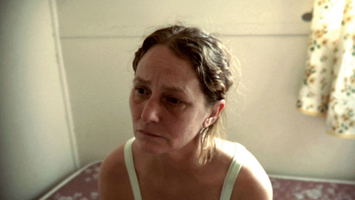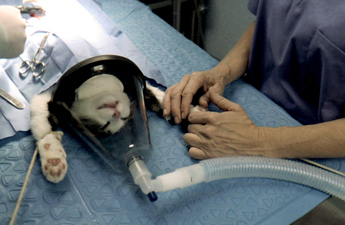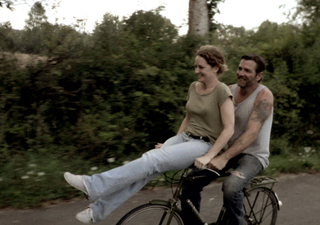A Conversation With Brian M. Cassidy and Melanie Shatzky (FRANCINE)
Documentary filmmakers Brian M. Cassidy & Melanie Shatzky had it in mind to shoot Francine, their narrative feature debut, with a documentary style approach, to the extent that they never planned to cast a seasoned actor in the lead role. But through a lucky turn of circumstances, Melissa Leo is now the star of the film. Francine is a dark story about a woman who is emotionally self-imprisoned and unable to change her life. Leo’s performance is yet another in a chain of remarkable character portrayals, and while the majority of the remaining cast members are local non-professionals, you wouldn’t know that by watching the film. Cassidy and Shatzky sat down with me in an Austin hotel during the 2012 SXSW Film Festival to discuss Francine, which comes on the heels of their latest documentary, The Patron Saints. Both films have their New York premieres at the 2012 BAMcinemaFest later this month (Francine: Friday, June 22nd, at 7pm; The Patron Saints: Monday, June 25th, at 7pm). Visit the filmmakers’ official website, Pigeon Projects, to learn more.
Hammer to Nail: Is it true that when you were about to make Francine, Melissa Leo actually found you guys?
Melanie Shatzky: Correct.
H2N: You were making some small micro-budget indie film with nonprofessional actors up in the Hudson Valley, and then she got wind of this project and contacted you?
MS: That’s right.
Brian Cassidy: Yeah, that’s exactly how it happened; it’s an unusual story. But we come from a background in documentary. We thought we would be playing to our strengths and to our available resources by casting non-actors in most of the roles.
H2N: Going for a more extreme form of naturalism?
 BC: Yeah, yeah. We thought we might find our Francine working as a waitress or at a gas station. That was what we thought we would do. We went to the Hudson Valley Film Commission in upstate New York, where the film is set and was shot. It turns out, the director of the film commission, Laurent Rejto, is good friends with Melissa Leo. He put out an ad for us, for some of the smaller parts through his email list.
BC: Yeah, yeah. We thought we might find our Francine working as a waitress or at a gas station. That was what we thought we would do. We went to the Hudson Valley Film Commission in upstate New York, where the film is set and was shot. It turns out, the director of the film commission, Laurent Rejto, is good friends with Melissa Leo. He put out an ad for us, for some of the smaller parts through his email list.
H2N: And Leo responded?
BC: Yeah, Melissa Leo is from the area. She’s on Rejto’s email list. She read the description of the film and reached out to us through him, asking if we would want for her to be our Francine.
H2N: “We’ll get back to you.”
BC: [BC laughs] Yeah, so it was a very unusual and fortuitous thing that happened. Then we met with her to discuss the role at a diner in Kingston, NY. After that there were just logistics and things to work out, to make it work with her schedule… contractual things. But from that moment on, we knew that we wanted to work together. We left that diner feeling like it was going to happen.
H2N: That’s amazing. And did you think from that point that you had to maybe shift your approach to casting the rest of the film? She must have already known through the ad that you were going to cast nonprofessionals?
MS: Yeah, she knew that. We’d never even thought about it any other way. Everyone else would be a non-actor or a nonprofessional actor or local actor. And she’s used to working with people like that, so she’s very comfortable, and it was seamless.
MS: She was patient in terms of bridging that gap.
BC: I think it also helped that the character of Francine is very much the center of the film. I mean, she’s in every frame of the film, and the movie is called Francine, and it’s very much Francine’s story. And so the commitment of having to work with actors of a different caliber or with almost no experience, was sort of minimal. In a lot of cases, she helped them. She was able to help bring them to a different level by just sort of giving them certain things that they might not know they needed, things to react off. So she was very good with them, very good.
H2N: Another component of the casting are all the animals in the film. How did that work? What was that process like, between finding the stable and all the dogs?
 MS: We worked with a local rescue organization, which had a whole bunch of dogs and cats. In addition to that, there were a few locals who owned professional dogs, you know, dogs that had been in commercials before. But the bulk of the animals came from one family; a mother and a daughter.
MS: We worked with a local rescue organization, which had a whole bunch of dogs and cats. In addition to that, there were a few locals who owned professional dogs, you know, dogs that had been in commercials before. But the bulk of the animals came from one family; a mother and a daughter.
H2N: So they are nonprofessional animals, is that what you’re saying?
[BC laughs]
MS: There were a couple [of professionals], but they didn’t even make it into the film, because there were particular animals that were very comfortable with each another.
H2N: But did the professional working dogs feel comfortable working with the nonprofessional dogs? [All laugh]
BC: The people that were kind enough to bring these animals, they were very professional in terms of knowing when the animals could all be together, when they needed to be separated, so yeah, behind the scenes it was quite well orchestrated, and there’s a high degree of responsibility when dealing with animals on a set. And we had the ASPCA there with their clipboards…
MS: …the Humane Society.
BC: Oh, I keep saying ASPCA, sorry it was the Humane Society!
H2N: The scenes of Francine’s home and, specifically the scenes with her pets, are really disturbing. Are you concerned at all about the reaction from audiences? Because there’s always going to be those folks, no matter what steps you take, that are going to make a fuss.
MS: We were worried about that, but not one person has said anything yet.
H2N: Well, you haven’t done any public screenings.
MS: Oh, okay, but I mean, no animals were harmed in the making of the film, and obviously, the euthanasia scene is not an actual euthanasia.
H2N: I read that it was an anesthetizing.
MS: Right, because the dog was just getting his teeth cleaned. And so everything that happened in the vet’s office, those were real scheduled appointments. So we didn’t know what procedures we were going to profile. It was just based on what that real vet had scheduled that day, and so we basically just incorporated Francine into those scenarios.
H2N: Those scenes are dynamite.
BC: Yeah, I think those scenes, really they’re extraordinary, and I just love them. You know, you finish a film and you kind of don’t want to watch it too much afterwards, you get tired of it, you know?
H2N: How so?
BC: You get tired of watching your own film, you know. In the case of this film, while it’s basically done for us, there are still certain things that are just wonderful to watch.
H2N: You mean certain textures of the film that you are still discovering?
BC: Yeah, there’s still something about watching the scenes with the animals. I don’t know, they still remain very alive to us.
H2N: There is so much texture in the film. And Francine’s constantly caging and uncaging the animals. Or, rather, she’s always looking in on these animals in their cages… I don’t know if that was intentionally symbolic in any way. In your Q&A [after one of the SXSW screenings] I attended, you guys kind of talked more about her home sort of being a prison for these animals, like you know, the conditions and whatnot. But I was wondering if those ideas were in the script or was that something that you discovered through working with Melissa?
MS: What specifically?
H2N: Just the more allegorical aspects of the movie—if that’s the right way to put it—the story that was going on kind of underneath, the subtext of the film. Certainly she’s in battle with herself.
MS: Oh that was all intentional. That was in our treatment. Of course, our script was only 10 pages long.
H2N: Wow, yeah. There were a lot of silent scenes in Francine. She wasn’t a talker.
 MS: However, the scene descriptions in the script were very vivid. We didn’t write very much dialogue because we didn’t want there to be much dialogue. So, you know, the scenes were written out very clearly, what would happen, but from point A to point B we wanted that space where the actors could find their own way.
MS: However, the scene descriptions in the script were very vivid. We didn’t write very much dialogue because we didn’t want there to be much dialogue. So, you know, the scenes were written out very clearly, what would happen, but from point A to point B we wanted that space where the actors could find their own way.
BC: So it’s not at all that it’s an improvised film, I think that could be misconstrued.
H2N: That’s what I was going to ask.
BC: It’s not an improvised film. The silences were a way to just to sort of breathe life into it, and have this sense of what you’re seeing, you’re seeing for the first time. We did a lot of location scouting to get the sense of what the space was going to be like, but we didn’t do a lot of blocking beforehand, we didn’t have a written shot list.
MS: Right, there was no shot list.
H2N: So the locations in the film were part of the casting as well.
BC: Yes. We had some idea of what we wanted to do but really we wanted to get into those spaces that we so lovingly cast, you know, the spaces themselves. And then sort of have the room to say, well maybe it’ll happen over here. You know, actually, the light is doing something beautiful over here and there’s enough room for it to happen over here.
H2N: So it’s liberating in that way not to be so locked in.
BC: It was liberating. But you also have to think on your feet more, because you’ve got—we had a lot of locations in the film in a very compressed time frame. We had a 21-day shoot and a lot of locations. So there was [a feeling] that we had to get in, and get what we needed to get. There was just a lot that needed to be done after that.
H2N: How many locations were there?
MS: Ooh, Katie, how many locations did we have? Like 35?
Katie Stern [producer of Francine]: Yeah between 30-35.
H2N: And what did you shoot with?
BC: Yeah we shot it with an HVX camera with an adaptor that accepts film lenses, so we used film lenses.
MS: And Brian shot it.
BC: I shot it. It was all handheld, which gave us lots of latitude to move around and not get locked in… not lock the actors into a particular lighting scheme, you know. We were able to sort of clear people out of the way of the shoot and have a wide swath of shooting room.
H2N: That space again. Did the nonprofessional actors feel less stressed because there wasn’t so much dialogue—even though Francine seemed to have the least, perhaps only Jean Dujardin had fewer lines than she did.
BC: [BC laughs] Probably.
H2N: But were the other nonprofessionals able to be more in the moment and not have to worry so much about lots of dialogue as a result?
MS: Yeah, I think so. I think that kind of put them at ease to find their own voice in their scenes.
H2N: Yeah, they were so natural. Both of the other lead parts are worth mentioning. Linda was played by Victoria Charkut and Keith Leonard played Ned.
MS: Yup.
H2N: Two terrific actors. Their careers will probably change some after this movie, I would expect. Did you guys carve out much time for rehearsals?
MS: No…
MS: We wanted to keep it fresh.
H2N: So just retakes.
MS: We knew how golden most of the scenes were, and you had to hear their own voice unrehearsed.
BC: What we wanted to avoid was for certain actors to go home and do work with their other family members or something.
H2N: You wanted them to work more here [pointing at heart] than here [head]. I think you ended up with very natural performances from everyone in the film.
MS: I hope so!
BC: I hope so for them too. They were such great discoveries—we were so lucky to have found them. I think we cast them based on their strengths and their abilities and how they fit their roles, and then gave them the room to find their own words. That, combined with playing off of Melissa. Again, she was able to help them, occasionally whisper in their ears and say to them… whatever happens between actors… we got the sense that she was able to help them at times. Then we were able to help them. It all went quite well.
— Adam Schartoff













Pingback: 12 Quick ?s — BRIAN M. CASSIDY AND MELANIE SHATZKY – Hammer to Nail
Pingback: THE 2012 HAMMER TO NAIL AWARDS – Hammer to Nail